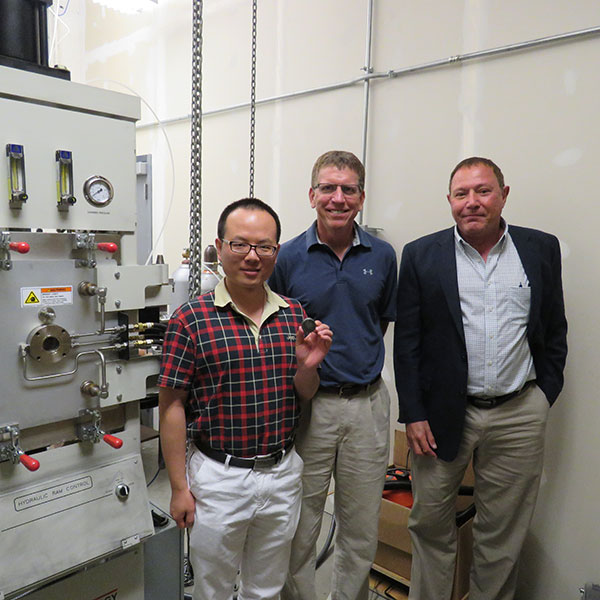Calendar Icon
Jul 27, 2018
Person Bust Icon
By Karl Vogel
![]() RSS
Submit a Story
RSS
Submit a Story

A recent grant from the Nuclear Regulatory Commission (NRC) will bolster engineering research into nuclear energy and could provide multiple benefits to the University of Nebraska-Lincoln College of Engineering, its future students and the State of Nebraska.
The Department of Mechanical and Materials Engineering received a three-year, $450,000 NRC Faculty Development Grant to support the research of Bai Cui, assistant professor of mechanical and materials engineering. Chair Jeffrey Shield and professor Michael Nastasi collaborated on the grant application, which is intended to support the research of younger faculty – defined as those in the first six years of their academic career.
Cui is developing new materials that can withstand extreme high temperatures (between 1,800 and 2,700 degrees Fahrenheit) and can resist damage from exposure to radiation. These materials will be used in the construction of the next generation of nuclear reactors that could generate electricity for much of America. Nebraska has one nuclear power station – the Nebraska Public Power District (NPPD) Cooper Nuclear Station, near Brownville.
Seed funding for this research came from the Nebraska Center for Energy Sciences Research (NCESR), which is funded by NPPD.
“The next generation of reactors are designed to be more efficient and safer. They will consume less fuel and generate more energy with less nuclear waste, and that will require them to operate at high temperatures,” said Cui.
Cui is working on a combination of two types of nanostructured materials. The first are oxide-dispersion-strengthened (ODS) materials that contain ceramic nanoparticles inside a matrix of either stainless steel or a high-entropy alloy (HEA) and are more stable and stronger at higher temperatures. The second, HEAs, may also offer a unique mechanism for recovery from radiation damage.
“This project would combine the benefits of these two different materials to make a better material,” Cui said.
“A synergistic effect,” said Nastasi, director of NCESR with which Cui is affiliated. “Together, hopefully, they will be more than just the sum.”
Since most nuclear power plants in the U.S. are beyond or nearing their operating life expectancies, the industry is working on a new, fourth generation of power plant designs.
“Generation III plants are now 20-or-more-years old and they are running at the optimum temperature for their designs,” Nastasi said. “The efficiency of the Generation IV reactors is temperature-dependent, but currently there is no material available that can be grandfathered in from the old reactors to do the job we want new reactors to do.”
Over the life of the grant, the mechanical and materials engineering department will gain from addition of new equipment, such as machines that will allow Cui and his research team to test new materials at high temperatures, and from the creation of new courses in nuclear energy engineering that will train both undergraduate and graduate students. The first of these courses – Introduction to Materials for Nuclear Energy Systems – should be available in fall 2019, Shield said.
And with nuclear energy creating 30 percent of the electricity consumed in Nebraska, the need for trained nuclear engineers will be constant.
“We’ve recognized that nuclear energy is going to be a big part of the future energy portfolio,” Shield said. “We have added significant expertise, including Bai, to address issues related to materials for the next-generation reactors. This project also impacts workforce development for the state and the nation. They’ll get the investment back because we’ll be training the next generation of engineers.”
Submit a Story

